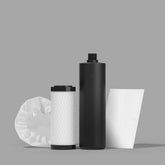Introduction to UV Log Reduction Study
Introduction to UV Log Reduction Study
The chart titled "UV Log Reduction Study" details and summarizes the results of multiple tests documenting the Ultra Violet “Dose” required to deactivate (by log increment) various Bacteria, Protozoa and Viruses. The purpose of this introduction is to help the reader better understand terms used in the chart, and to enable them to use this information as a tool to select a UV device appropriate for their specific application.
We begin with the terms Log Reduction and UV Dose and of how they relate to each other. We’ll also touch (lightly) upon how these are impacted by Flow Rate.
Log Reduction: a single log reduction represents a 10-fold (one decimal) or a 90% reduction in numbers of live microorganisms. This means, for example, that if 100,000 live bacteria are present, a one log reduction would deactivate 90% of them and reduce that number to 10,000. To continue in that vein, a 2 log reduction would reduce that remaining 10,000 bacteria by 90% leaving 1,000 and a 3 log would reduce the remaining 1,000 to 100, and a 4 log would reduce the remaining 100 to 10, a 5 log would reduce the remaining 10 to1. Ultimately the capability of any disinfection device is measured by its reduction of contaminants. Given this, it becomes clear that knowing what is contaminating your water is the critical first step. Beyond that determining the proper ‘dose’ to deactivate that contaminant is vital to selecting a UV system.
UV Dose (commonly referred to as “Dose”) refers to the total amount of radiant energy produced by a given UV light source inside a UV system. The most common unit of measurement for a UV dose is mJ/cm2 or W/m2. For example, a stated UV dose of “8” would actually mean a dose of “8 mega joules per square centimeter”.The effect of this “dose” on the organism is measured at a given flow rate. This combination of measurements tells us how long the microorganism must be exposed to a given level of radiant energy to be deactivated. It is important to note that Flow Rate becomes another factor here. Slowing the flow of the water through the UV device increases ‘exposure time’ thereby increasing the dose.
(Older US Public Health Standards required a UV dose level of 16 mJ/cm2, which is now only recommended for non-pathogenic organisms. The newer is 30 mJ/cm2, with a dose of 40 mJ/cm2 required for NSF and some U.S. State agencies are more effective in eliminating the threat of more ‘modern’ viruses and bacterium).
As you refer to the chart please follow the examples below for further explanation:
GOAL: to achieve a 4 (four) log reduction:
Example 1: Bacterium: Aeromonas hydrophila, Referring to the chart we see that a UV dosage of 5 mJ/cm2 is required to achieve a 4 log reduction of this bacterium.
Example 2: Virus: Adenovirus type 2 (human lung cell line). Referring to the chart we see that a UV dosage of 100 mJ/cm2 is required to achieve a 4 log reduction of this virus.
These two examples illustrate that vast difference in the ‘dose’ required to deactivate various contaminates. Clearly a UV system delivering a UV dosage of, 16, 30 or 40 mJ/cm2 would easily achieve a 4 log reduction of the bacterium Aeromonas hydrophila used in Example 1. However, none of those UV systems would be able to achieve even a 1 log reduction of the virus Adenovirus type 2 (lung) used in Example 2. Instead this virus would require a system with an output of (for example) 40 mJ/cm2 AND have the flow rate modified/restricted to increase exposure time, thereby increasing the effective “Dose” to at least 100 mJ/cm2, to achieve the required 4 log reduction.
- Choosing a selection results in a full page refresh.





